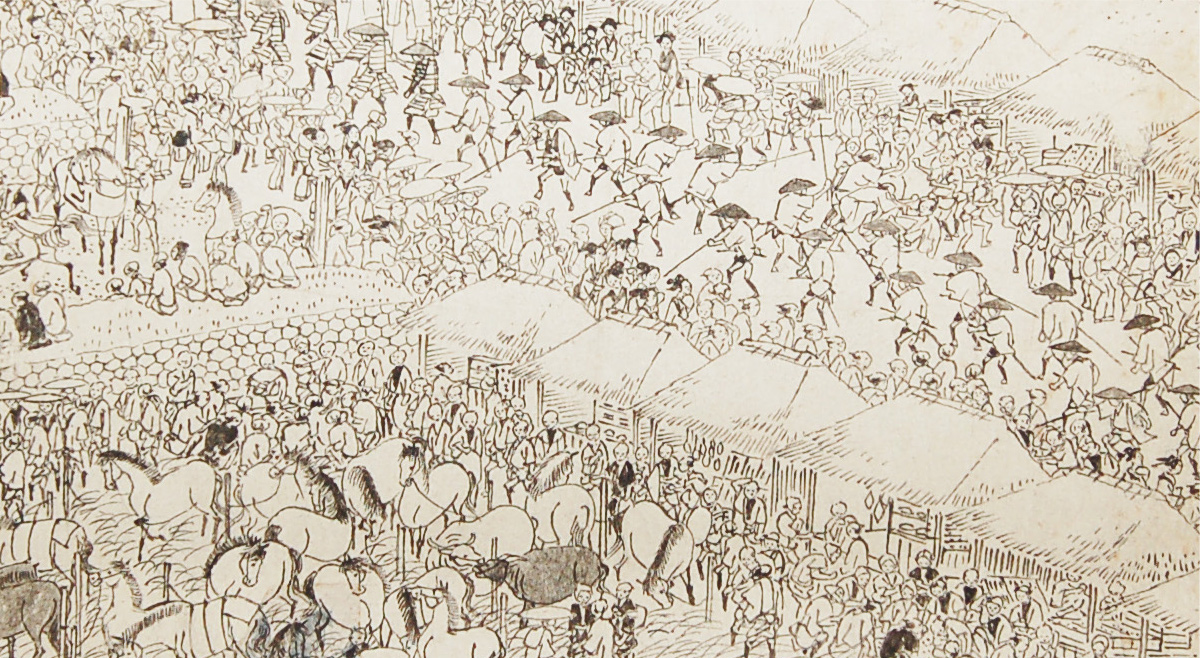Jizo Bodhisattva is a deity believed to offer salvation to all living things. As such, a high priest of Daisen Temple named Kiko decided to distribute paper charms invoking divine protection for the local livestock while also encouraging their grazing in the pastures around the mountain. His example soon resulted in the flourishing of a form of livestock worship in the Daisen area.
The Konjaku Monogatarishu collection of tales written in the early 12th century provides further insight into this peculiar practice. It tells of pilgrims visiting from far away with their horses and cattle laden with offerings and other luggage in tow. Though essential in the agriculture that was the pillar of their livelihoods, these pilgrims brought their livestock along on their pilgrimage to Daisen Temple. There, they received protective amulets and charms as well as watered their livestock at the Rishosui spring where the blessed water brought long life. Further, they hung these protective amulets and charms in the stables upon returning home as part of a continued prayer for the safety of their livestock.
During spring festivals at Mt. Daisen, livestock competitions featuring comparisons of cattle and horses raised in the pastures at the base of Mt. Daisen with those brought by pilgrims where held. This marked the beginning of a livestock trade that rapidly flourished from the Kamakura era (from 1185) and before long developed into a livestock market.
In the middle of the Edo era (from 1603), Daisen Temple became more active in the cattle and horse business, and a market was opened during the spring festival at a field at the base of the temple precinct called Bakuroza. This Daisen livestock market fostered by faith was unique all across Japan for the reason that it bore the characteristic of being under the aegis of a temple. Before long it was also held separately from the spring festival and began to draw such large crowds of people and their livestock from all over Western Japan that it became widely known as one of the big three livestock markets in Japan.
The hustle and bustle prevalent at the time is vividly portrayed in the fan print created by the last great master of the Ukiyo-e art tradition Hiroshige Utagawa as well as in the songs sung at feasts in celebration of the closing of a sale. Onlookers as well as merchants filled the bustling teahouse lined streets of Yodoe Harbor – especially with the arrival of a shipment of cattle from Oki Island famed for their strong legs.
The livestock market continued to economically support the region even after losing its connection to Daisen Temple due to the anti-Buddhism sentiment that accompanied the Meji Restoration in 1868. The frequency of the market increased to five times a year by the 1880s and, with over 10,000 head of livestock changing hands annually, grew into the largest livestock market in all of Japan.
At the same time, the central government began to encourage the breeding of cattle with imported crossbreeds in order to increase the production of beef cattle. However, the quality of the resulting beef cattle garnered a poor reputation leading to a rapid decline in the number of head of cattle in the prefecture and threatening the livelihood of local farmers. Sensing the seriousness of this situation, Tottori Prefecture started Japan’s first cattle registration program in 1920 as an initiative to restore the former quality of their superior beef cattle. Afterwards, the advent of various technologies such as the railroad brought the curtain down on the livestock market in the spring of 1937. However, the registration program continued to play a major role in improving the quality of local beef cattle and became a cornerstone for the development of the world renowned Wagyu Japanese beef brand.

